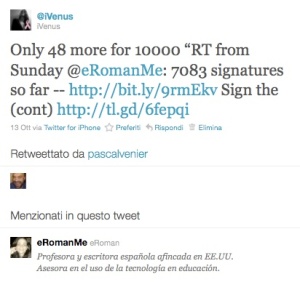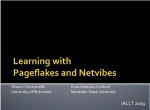Just 4 years into it…and now this!
In the fall, I had published an article on Italian teacher training in Foreign Language Annals (the journal for the American Council for the Teaching of Foreign Languages). Shortly before its publication, the editor had asked me to comment on the then recent decision of the College Board to no longer support the financial costs of administering the Italian Advanced placement exam. Here is my comment:
Worth noting are the results of the inaugural year of the Advanced Placement Italian Language and Cultural Exam, particularly with respect to New Jersey. Villa Walsh Academy in Morristown was recognized as an Exemplary AP Italian Language and Culture Program for small-size schools that “lead the nation in helping the widest segment of their total school population receive an exam grade of 3 or higher . . .” (The College Board, 2007, p. 52).
Notwithstanding the national results for the inaugural year, the College Board has announced the imperiled position of the AP Italian exam. Practitioners, politicians and ambassadors, and community supporters alike have mobilized in support of the exam (as evidenced by messages from the president of the American Association for Teachers of Italian, various letters of support, a recent meeting of the Ambassador of Italy to the United States with the College Board, etc.). It is the hope of this author that the ongoing negotiations with the College Board will soon yield positive results for the future of the AP Italian exam.
Here we are, just months later, the AP exam has been discontinued, with this ray of hope from the College Board:
[w]hile AP Italian will not be offered in 2009-10, if at some future date the funding partnerships needed to support an AP Italian program arise, the Board of Trustees will consider renewing work to develop and offer the AP Italian course and exam.
Between the two announcements, the Italian community came together and worked very hard to try to raise the $1.5 million (originally $4.5 but reduced in negotiations) required. This community raised a good chunk of the money, but everything was contingent upon the Italian government’s contribution of more monies. Unfortunately, the Italian government did not come through.
In an email sent today to the AATI, the president of the teacher’s association made the following comment:
By not having an AP in Italian, the Italian language acquires in certain quarters of society a de facto second-class status.
My personal take on this situation
I first read about the College Board decision on Jan. 8 in an article in the NY Times. Once the initial shock wore off, I did two things: tweeted it and then wrote an email to the president of the AATI. In his reply to me, he referred me to two other news articles: The Washington Post and the LA Times.
Having read the latter article, I was a tad annoyed that the presentation of stats compared Italian AP examinees and Italian high school programs nationally and in the state of California to Spanish. Uh, hello?! Did the journalist not reflect on the status of foreign languages in the US and realize that Spanish is not just another foreign language but rather a language of the US (since it does not have an official language)? I also emailed him and tried to explain to him that his presentation of the statistics was not an equitable comparison for Italian. I used the adage “comparing apples and oranges” and that Italian has always been and should be compared to French and German, the other foreign languages that maintain a foreign language status in the US, unlike Spanish, which is a second language for all intents and purposes. Well, his reply to my request for a follow-up paragraph accurately representing the reality of the Italian AP exam within the context of foreign languages was rather dismissive. So I will, for the sake of making some noise, post it here. In 2008:
- Italian AP had 1,529 examinees and increased by 18% since 2007.
- French language AP had 20,675 and German 5,259.
- Both, however, experienced a decrease since 2007 (-5% and -3% respectively).
Yes, economically speaking, the exam is not financially feasible…but we are growing, not at the initial projected rate, but let’s face it, we aren’t Spanish!
What options are available?
First and foremost, the idea of taking the test via computer vs. pencil and paper. Terminally Incoherent’s blog post about electronic test taking gives some examples as to benefits and pitfalls of these types of tests. Financial justification by the College Board cannot be the only reason to go this route.
Next, find more money. We are in the midst of the worst recession since pre-WWII across the globe. Can we really be expected to find more money? Unfortunately, Italian has been considered the “stepchild” of modern foreign languages, given the limited number of speakers of it world wide (according to Wikipedia, Italian ranks 20th in terms of native speakers, and it is an official language in: Italy; Vatican City and San Marino, both geographically located within Italy; Switzerland; Croatia; Slovenia). So to whom can we turn for financial rescue? Obviously, Berlusconi’s government is unable to fulfill previous promises given Italy’s economic turmoil. Italian Americans? Many of them who have already generously promised monies must be applauded. They recognize the value of maintaining language in tandem with culture (funny how many people label themselves Italian American but cannot speak the language and for the most part, don’t encourage their children, grandchildren to study the language/cultural formally).
Another possible strategy? Find ways to lower the cost of grading the exam. I have never been involved in grading it (but I have been invited to be a reader this summer), but I can appreciate the entire grading process. Language learning isn’t just right/wrong answers, it is negotiation of meaning, free writing, persuasion, narration. There is also an oral component that needs to be evaluated. Finally, the 0-4 grading scheme is revisited every year in light of the test-takers.
What else can be done? I’m not sure.
I hope that we can reinstate the AP exam in the future.
 Imagine walking into a mid-size, clean, welcoming seminar room for a morning presentation. It does not seem imposing, but you discover once you begin to set up that this room is equipped with tools that you haven’t ever encountered. Quite impressed I was with just the concave wall upon which my presentation was projected, reminding me that sometimes things can become larger than life, and that it is not all that bad. I was mesmerized as Ron Owston, Director of the Institute for Research on Learning Technolgies at York University, increased the size of my opening slide to Goliath proportions. Here I am pictured with Ron, and Roberta Sinyor of the Department of Languages, Literatures & Linguistics, literally before my talk.
Imagine walking into a mid-size, clean, welcoming seminar room for a morning presentation. It does not seem imposing, but you discover once you begin to set up that this room is equipped with tools that you haven’t ever encountered. Quite impressed I was with just the concave wall upon which my presentation was projected, reminding me that sometimes things can become larger than life, and that it is not all that bad. I was mesmerized as Ron Owston, Director of the Institute for Research on Learning Technolgies at York University, increased the size of my opening slide to Goliath proportions. Here I am pictured with Ron, and Roberta Sinyor of the Department of Languages, Literatures & Linguistics, literally before my talk.










